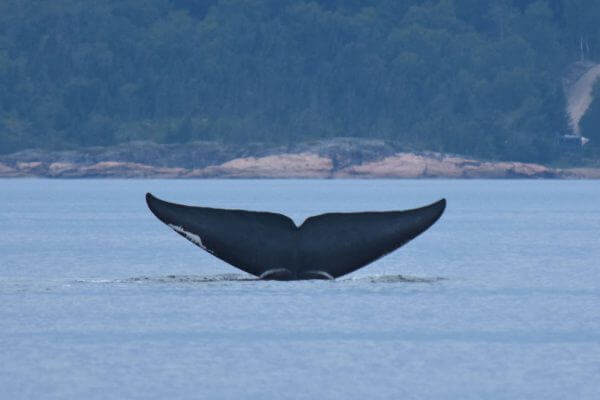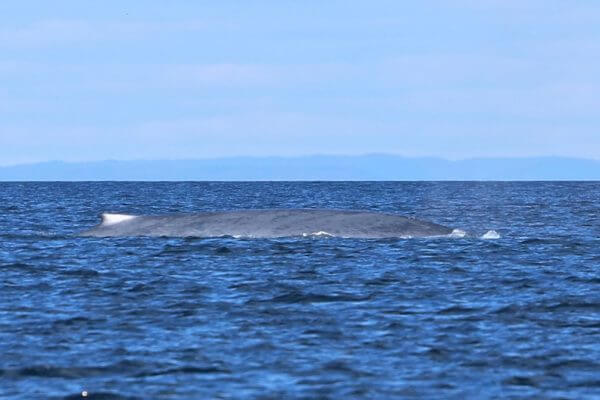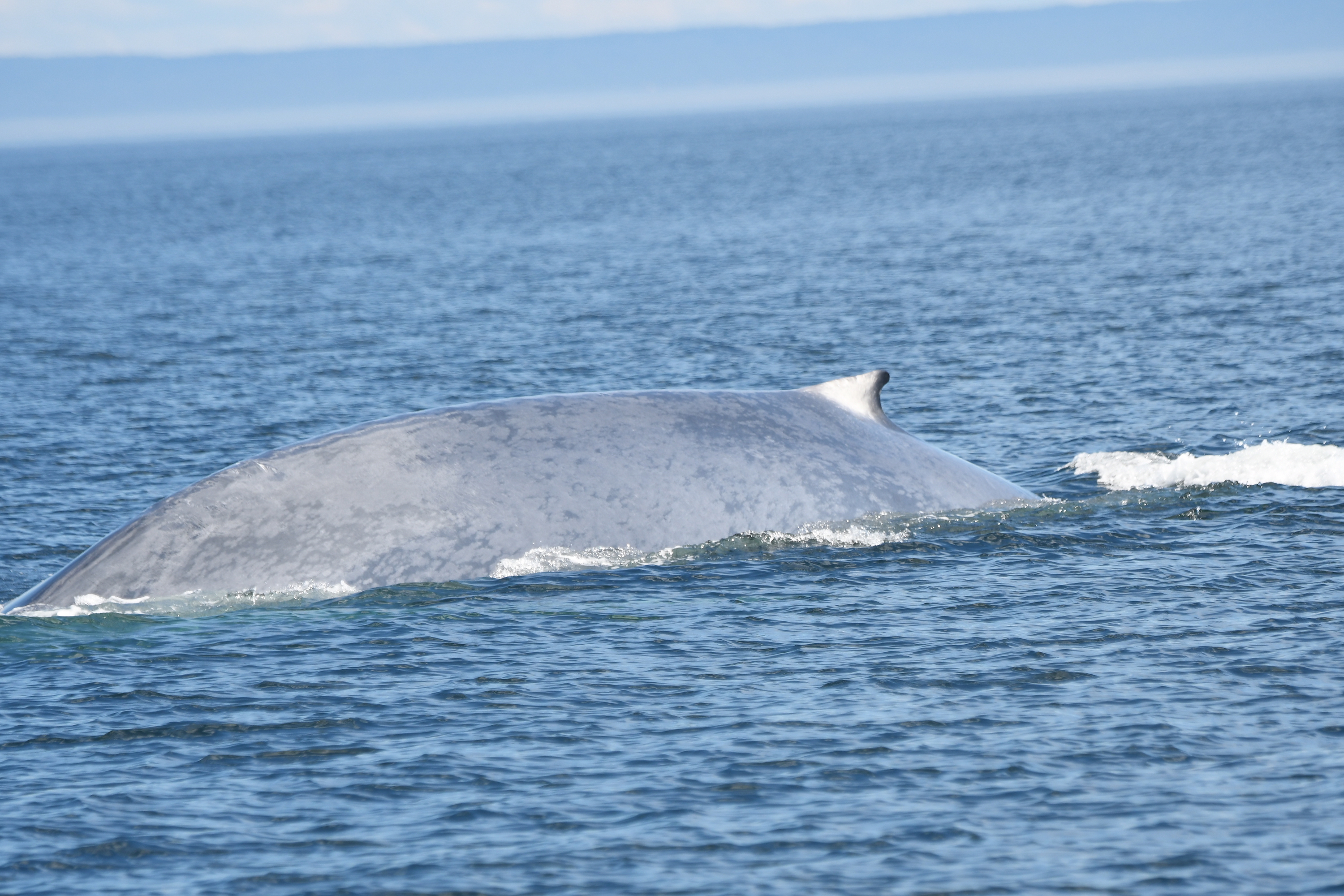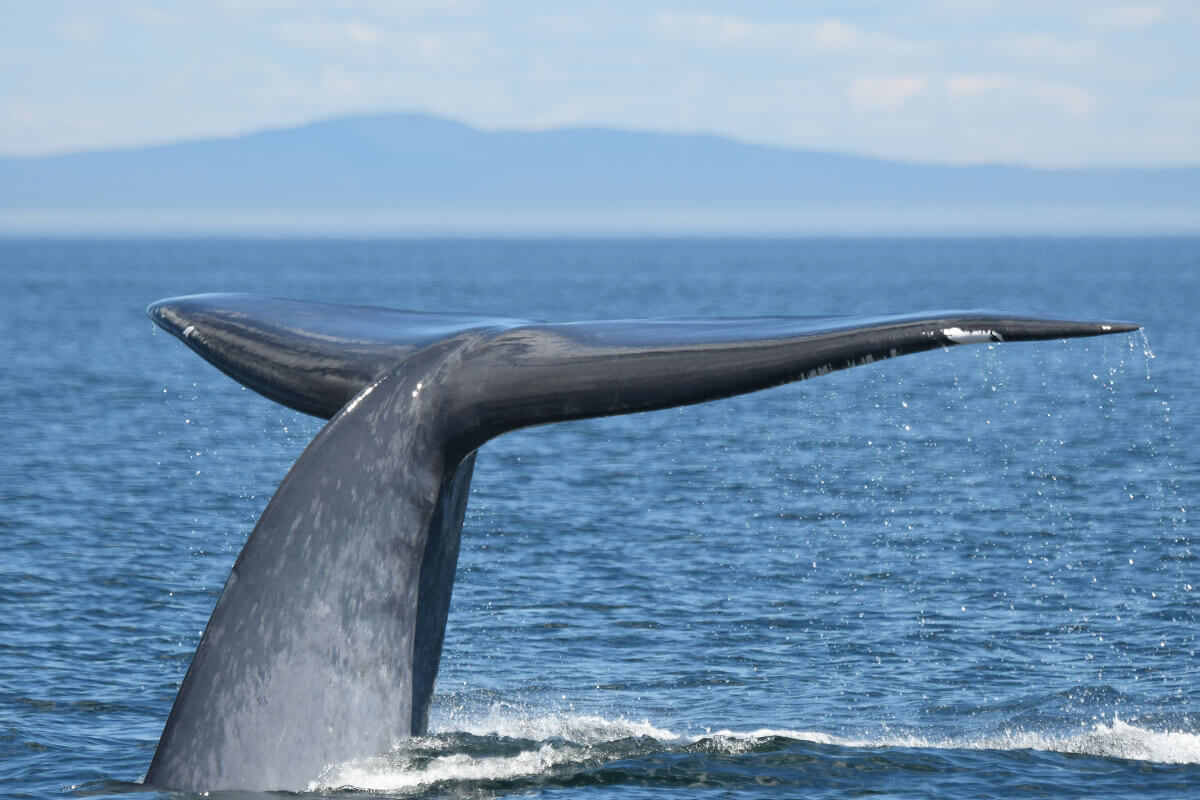Jaw-Breaker
Blue Whale


-
ID number
B246
-
Sex
Female
-
Year of birth
Unknown
-
Known Since
1991
Distinctive traits
Jaw-Breaker is one of the 15 to 18% of St. Lawrence blue whales that fluke their tails when they dive. It is in fact when she raises her tail that the white spot located on the edge of the left lobe of the tail, on the side of its belly, can be seen.
This female also has a particularly pale, even shiny dorsal fin.
The pigmentation pattern of her back also confirms her identity.
Life history
Jaw-Breaker is a female blue whale well known to the Mingan Island Cetacean Study (MICS). Although she is often seen in the estuary, she is rarely observed in the Gulf.
The origin of her name seems to have been lost over time. According to the MICS team, it may be related to the hard candies called “jawbreakers,” or to aggressive behavior she has shown toward other blue whales.
Observations history in the Estuary
Years in which the animal was not observed Years in which the animal was observed
Latest news from the publications Portrait de baleines
The public and those working around the Saguenay–St. Lawrence Marine Park were thrilled to see Jaw-Breaker, aka B246, again on September 2! A month earlier, this female blue whale made her first appearance in the estuary for the season, then disappeared for a few weeks. Where did she go? For now, no one knows! Nevertheless, her return is heartwarming for many people. There aren’t many giants like Jaw-Breaker who return to the estuary year after year! Known since 1991 by the Mingan Island Cetacean Study (MICS), Jaw-Breaker is recognizable by the white patch under her tail fluke, which she regularly shows when diving. Despite often appearing calm and composed, Jaw-Breaker sometimes seems to have a rather fiery temperament. She has been seen on a few occasions by the MICS team intimidating male blue whales, notably by blowing and growling in their direction! Perhaps her name, which means “breakneck” in French, comes from this difficult character? Stable male-female pairs sometimes form during the summer in the St. Lawrence, associations that are precursors to reproduction and sometimes involve rumba sessions when other males get involved — see page 4! Could Jaw-Breaker’s aggressive behavior toward males be related to all this?
B246, or Jaw-Breaker, thrilled several observers on August 10 when she was spotted near Les Escoumins in the St. Lawrence Estuary. This first confirmed sighting of a blue whale in the estuary this year is particularly exciting because Jaw-Breaker was not alone: she was accompanied by a calf! The calf has been nicknamed “Nut-Cracker” by the Mingan Island Cetacean Study (MICS). Mother-calf pairs of blue whales are very rarely observed in the St. Lawrence. According to Richard Sears, president of MICS, this pair is the 35th to be recorded in the river in 44 years. Jaw-Breaker is all the more exceptional because this is the second time she has brought a calf to the area: in 2018, MICS documented her with a calf in the Gulf of St. Lawrence.
Last Wednesday, the GREMM research team had the opportunity to capture images by drone to measure the two individuals. At just over 22 m long, Jaw-Breaker is rather small for a blue whale, which averages between 21 and 28 meters. Generally, blue whales in the southern hemisphere are longer than those in the northern hemisphere, but females are larger than males. This female from the northern hemisphere is still a giant, however: her tail fin has a span of about 5 m, the size of a beluga whale! Her calf, which is about 6 months old, already measures more than 14.5 m.
A powerful breath, an interminable grey-blue back, and suddenly, in the sky, a tail composed of two large black palettes adorned with a white spot. This is the Jaw-Breaker effect!
Known since 1991, this female blue whale is one of the stars of the Marine Park. She is a regular visitor to the Estuary – we come across it almost every year – and one of the rare blue whales of the St. Lawrence to raise its tail when she dives. The origin of her name is believed to come from the colouring patterns on its back, which are reminiscent of the hard candys called “jaw-breakers”. But it also seems to fit well with her character. I’ve seen her a few times have a pretty aggressive attitude with males approaching her,” laughs Richard Sears of the Mingan Island Research Station (MICS). The first time, with Biombre [another female blue whale], Jaw-Breaker intimidated a male by blowing and growling. Another year, it was Pulsar, a large male, that she confronted face to face. “Researchers who approached her by boat to perform a biopsy also found her in a difficult mood.
Jaw-Breaker is one of a small handful of blue whales that ventured into the Marine Park this summer. Their visit seems brief, but for a blue whale, the estuary is a very small space, in which they zigzag in search of pockets of krill rich enough for their appetite; these giants can gobble up to 4 tons of it per day!
This week, we introduce you to three blue whales that were recently identified in the Marine Park. The individuals are differentiated by the coloring pattern of their backs. Also, in the St. Lawrence, 15 to 18% of these whales show their tails when they dive. This is the case of Jaw-Breaker: her tail has a white spot that is easy to identify, but pay attention to details, she is not the only one to have a spot at this location.
B093 is one of the oldest males known and identified by the Mingan Islands Research Station (MICS) directed by Richard Sears. Identified several times in the Estuary in 2012, B093 had been observed off Nova Scotia. This year, it was observed by several cruise ships off Les Escoumins and Les Bergeronnes. B197 is also one of the blue whales seen in the Marine Park in recent weeks. As for Jaw-Breaker, this star was finally observed. Two other blue whales have also been identified in the Estuary in recent weeks: B275 and B236.
Blue whales are animals that are often observed alone. However, in the St. Lawrence, they sometimes form more or less stable pairs in early fall. These associations last for more than a day, up to entire weeks. According to MICS biopsy follow-up, they are most often male-female pairs. The formation of pairs could be an early sign of reproduction in these animals that takes place during the winter season. Sometimes a second male joins the pair and all three individuals participate in what is called a rumba; the female swims in front and the two males compete to be closest to her. After a race, which can last several hours, one of the males abandons the race and the other becomes the female’s escort. Do these pairs really result in the reproduction of both individuals? A difficult question to answer in the short term! In 2010, B093 was observed participating in one of these rumbas.
Jaw-Breaker is a female blue whale well known to the Mingan Island Cetacean Study (MICS). Although she has been observed a number of times in the Estuary, she has never been seen in the Gulf of St. Lawrence. Jawbreaker is recognized by the white spot on the underside of her tail.
However, as she is not the only blue whale to show this trait, we must rely on other criteria such as the pigmentation pattern of her back to confirm her identity. Also, her dorsal fin is light in colour, almost shiny. Only 15-18% of blue whales raise their tails out of the water when they dive. Jawbreaker is one of those individuals. This season, numerous employees of the whale-watching industry and visitors were able to observe this behemoth off the coast of Les Escoumins. Rare and fragile, the blue whale is an endangered species, having been decimated by rampant hunting in the North Atlantic that ended in 1955. In the Marine Park, an observation distance of 400 m must be respected.
MICS has been studying blue whales in the St. Lawrence since 1979. In the Northwest Atlantic, from the northern Davis Strait (between Greenland and Canada) to Bermuda, along the east coast, its researchers have identified over 475 individuals. This year, a big breakthrough in blue whale research was made. An individual photo-ID’d in 1984 in the St. Lawrence was found 30 years later in the Azores and again in the St. Lawrence, in the Gaspé, in 2015. This first ever documented sighting of a blue whale migration on an east-west axis, between the Gulf of St. Lawrence and the eastern part of the North Atlantic puts things into perspective. Measuring 25 m long and travelling hundreds or even thousands of kilometres, these giants live on a completely different scale.
Jaw-Breaker has been a regular visitor to the St. Lawrence Estuary for almost 25 years. She has been spotted two or three times off the coast of Matane and the Gaspé Peninsula since the Mingan Island Cetacean Study (MICS) began its research on this species in 1979.
This summer, she was spotted near Les Bergeronnes from land-based observation sites at the end of July. Her white patch on the right side of her dorsal fin is easily visible from a distance. However, other blue whales have a similar characteristic. The GREMM team confirmed her identification on August 5.
Another behavioral peculiarity: she raises her tail when she dives, as only 15 to 18% of blue whales do. This allows us to see a white spot on her left lobe.
It is estimated that 5 to 10 blue whales are currently present in the Saguenay–St. Lawrence Marine Park (SSLMP), a summer feeding ground that is very rich for them and essential for them to build up their energy reserves for the rest of the year. It is also an exceptional region for observing the largest animal that has ever lived on earth: from land-based sites, and for excursionists and boaters who usually only have to travel a short distance to see them.
The blue whale has been classified as endangered in Canada since 2002. The MICS catalog lists 475 North Atlantic blue whales that its team has identified over the past 35 years, including only 22 newborns. This highly vulnerable population has not recovered since whaling was banned in the early 1960s. There are believed to be only 250 mature adults left in the Northwest Atlantic.
The marine park team is asking all boaters to exercise increased vigilance during this busy period for blue whales and other marine mammals. When these whales gather in the same area or when sea conditions deteriorate, it is important to reduce speed and be on the lookout to increase the distance between you and them. Parks Canada has issued multiple messages to users this week: complying with the Marine Activities Regulations is a legal obligation aimed at ensuring the protection of marine mammals and the safety of visitors.
Jaw-Breaker is one of the blue whales that is particularly fond of the St. Lawrence Estuary: although well known to MICS researchers, she has never been seen in the Gulf. She usually shows her tail when diving, a personality trait that she shares with approximately 15-18% of individuals of her species photographed in the St. Lawrence.
Since the beginning of summer, the GREMM has counted at least four different blue whales in the Marine Park, including Jaw-Breaker. The latter has been observed from time to time since June 25. Nomadic, blue whales are constantly on the move in search of better patches of krill, small planktonic crustaceans that congregate in immense “clouds” driven by currents, tides, and underwater relief.
Why “Jaw-Breaker”? It seems that the origin of her nickname has been lost over the years! After being consulted, the MICS team believes that there may be a connection with the hard candy “jawbreakers”, or else with an aggressive behaviour that she might have shown toward other blue whales.
The blue whale is a species at risk; its Northwest Atlantic population is unknown, but it is considered unlikely that it exceeds 250 adults. Disturbance by boats may be detrimental to its feeding. In the Marine Park, these animals enjoy enhanced protection: boats are required to stay at least 400 m away. Outside of the Marine Park, member companies of the Eco-Whale Alliance have undertaken to abide by these same limits to better protect them.
Blue whale Jaw-Breaker in the Estuary in 2013 © GREMM
This female blue whale was observed in several areas of the estuary in August. Jaw-Breaker is one of the 15 to 18% of blue whales in the St. Lawrence that show their tails when they dive. When she raises her tail, you can see the white spot on the edge of her left tail lobe, on the ventral side. She is also distinguished by her white dorsal fin. Please note that other blue whales also have this distinctive feature. This regular visitor to the estuary, known since 1991, has only been absent twice, in 1992 and 2000, and to date has never been photographed in the Gulf.
From August 25 to 30, a project to track blue whales in the estuary was carried out, a collaboration between GREMM, MICS, and DFO. The objective: to learn about the feeding habits of these giants. On August 25 at 1:46 p.m. off the coast of Bon-Désir Bay, the Bleuvet team placed a radio transmitter on Jaw-Breaker’s back. The next day at 5:49 a.m., the transmitter detached. However, with strong winds blowing over the estuary, it was not until the following morning, August 27, that it could be recovered off Île Rouge. And what did this 16-hour underwater tracking reveal? According to initial analyses, Jaw-Breaker alternated between feeding at the surface and deep dives of up to 100 meters, while at night it remained at a depth of about 15 meters. Based on the animal’s behavior and swimming speed, of the 898 dives tracked, 160 were feeding dives.
The dotted line represents the movements of the Bleuvet, which followed Jaw-Breaker at a distance of 400 to 600 meters on August 25 between 1:46 p.m. and 7 p.m. A better understanding of the behavior and movements of these giants helps us to better understand their needs and to base conservation measures on solid scientific foundations.




